Physical Address
304 North Cardinal St.
Dorchester Center, MA 02124
Physical Address
304 North Cardinal St.
Dorchester Center, MA 02124
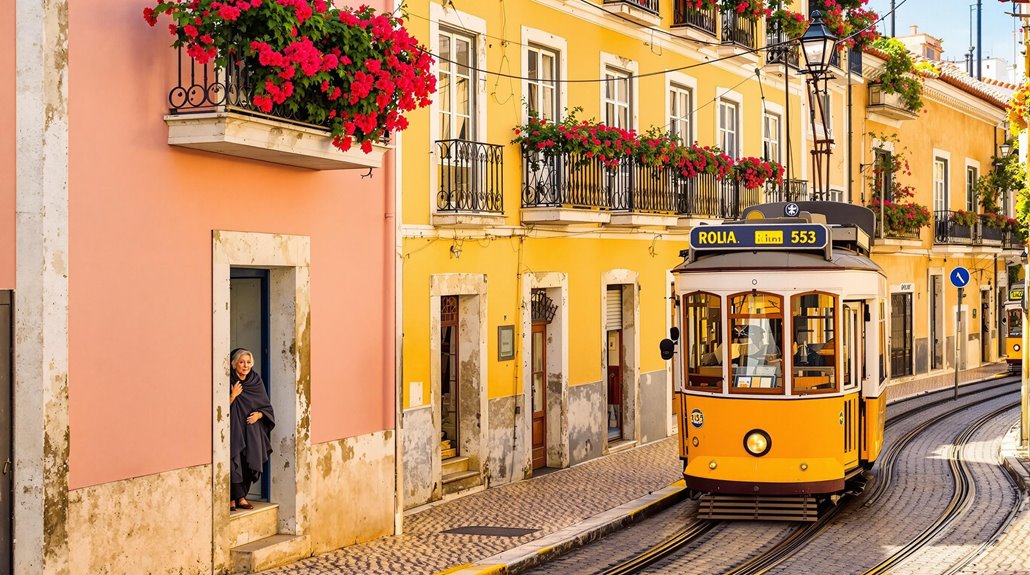
Lisbon captivates you with its perfect blend of old-world charm and modern vibrancy, where you’ll find three-course lunches for under €15 and wine cheaper than bottled water. You can explore UNESCO-protected Fado music in Alfama’s alleys, discover political street art in Bairro Alto, and enjoy free entry to monasteries on first Sundays. The city’s commitment to sustainable tourism, year-round mild weather, and strategic location make it an ideal base for Portuguese adventures, with countless treasures waiting to be uncovered.
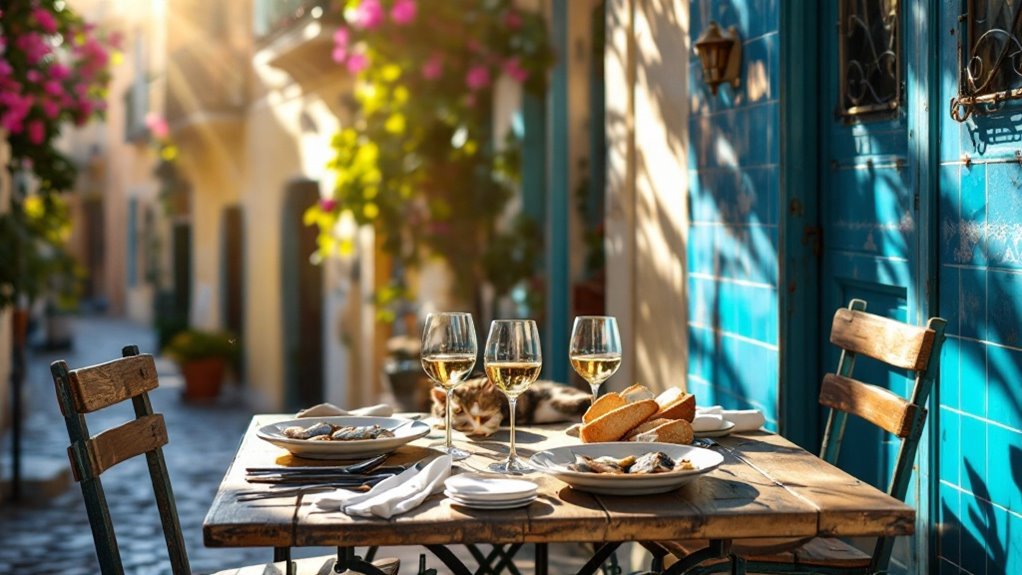
Three essential elements define Lisbon’s cherished lunch culture: time, tradition, and taste.
You’ll find locals lingering over three-course meals between noon and 3 PM, savoring everything from caldo verde soup to fresh-caught fish. The city’s tascas and neighborhood eateries offer prato do dia specials for €8-15, making authentic Portuguese cuisine accessible to everyone. Travelers exploring plant-based Austrian cuisine can find similar lunch specials in Graz.
Savor Lisbon’s midday magic, where €8-15 prato do dia specials transform lunch into an affordable culinary adventure.
For your best lunch experience, skip the tourist spots and head to family-run establishments like A Provinciana or Time Out Market. Most restaurants serve their meals with wine at lunch, a common practice that perfectly complements the dining experience. Vegans can enjoy traditional Portuguese flavors at many restaurants offering plant-based alternatives to classic dishes. The city’s vegan-friendly restaurants are transforming traditional recipes while maintaining authentic Portuguese tastes.
You’ll join Portuguese families and office workers as they enjoy their 60-90 minute breaks, starting with soup, moving to hearty mains like bacalhau or bitoque, and finishing with a pastel de nata and bica espresso.
It’s not just a meal—it’s a daily ritual that’ll make you feel like a true Lisboeta.
Speaking of Portuguese dining customs, you’ll find another pleasant surprise in Lisbon’s remarkable wine culture.
While tap water costs mere cents per liter, you can discover high-quality local wines for as little as €2.50 a bottle, with mid-range options averaging just €4-€5. In restaurants, you’ll often notice that ordering a full bottle makes more economic sense than purchasing by the glass.
What makes this value even more impressive is Portugal’s rich viticultural heritage, featuring over 250 native grape varieties. The recent rise in water prices has made wine an even more economically attractive beverage option for both locals and travelers.
You’ll encounter unique blends from up-and-coming regions like Bairrada and Trás-os-Montes, where sustainable farming practices help keep prices low. Choosing local wines supports eco-conscious viticulture that minimizes environmental impact while maintaining traditional methods.
Many digital nomads gather at local wine cafes to work while enjoying these affordable Portuguese wines.
For a more authentic experience away from tourist hotspots, explore local neighborhood wine bars where locals gather for their evening drinks.
Don’t miss the budget-friendly vinho verde, available for under €1 per liter, or take advantage of frequent wine promotions in local markets and supermarkets.
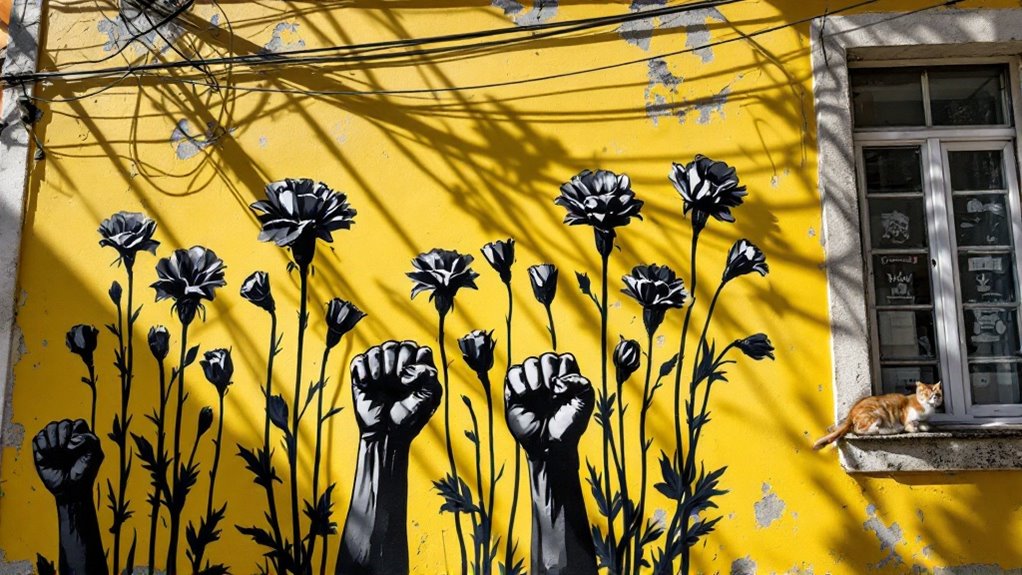
Beneath Lisbon’s sun-bleached facades lies a vibrant political consciousness expressed through one of Europe’s most dynamic street art scenes.
You’ll find thought-provoking murals that trace back to the 1974 Carnation Revolution, when artists used city walls to spread anti-dictatorship messages. The evolution of street art continued through the 1980s and 1990s, expanding beyond political themes into broader artistic expression. Many of these vibrant areas have become hidden gems for conscious travelers seeking authentic cultural experiences. While travel alone may not transform you, engaging with Lisbon’s political consciousness through its street art offers genuine cultural understanding.
Like Argentina’s economic challenges that inspire social commentary in its urban art, Lisbon’s walls tell stories of transformation and resistance. Today, the city’s Galeria de Arte Urbana has transformed once-illegal graffiti into celebrated cultural expressions, with over 500 significant works dotting the urban landscape.
When the sun sets over Lisbon’s terracotta rooftops, the city transforms into a mesmerizing nocturnal playground that pulses with energy until dawn.
You’ll find centuries-old traditions merging with modern revelry across distinct neighborhoods, from the graffiti-adorned streets of Bairro Alto with its 200+ bars to the sophisticated clubs of Cais do Sodré. While exploring solo, remember to stay in well-lit areas and stick to populated streets.
Don’t miss an intimate fado performance in Alfama, where UNESCO-recognized music fills historic venues as you savor traditional cod dishes. The enchanting performances typically start from 21 euros per concert.
For spectacular evening views, head to São Jorge Castle or one of the city’s illuminated miradouros, where you can gaze at the twinkling cityscape until 2 AM.
Many of Lisbon’s progressive bars embrace queer culture, offering inclusive spaces that celebrate diversity through both entertainment and plant-based dining options.
End your night at Time Out Market, sampling local delicacies among locals and fellow travelers until midnight. Join a culinary tour guide to discover hidden gems and authentic Portuguese flavors throughout the evening markets.
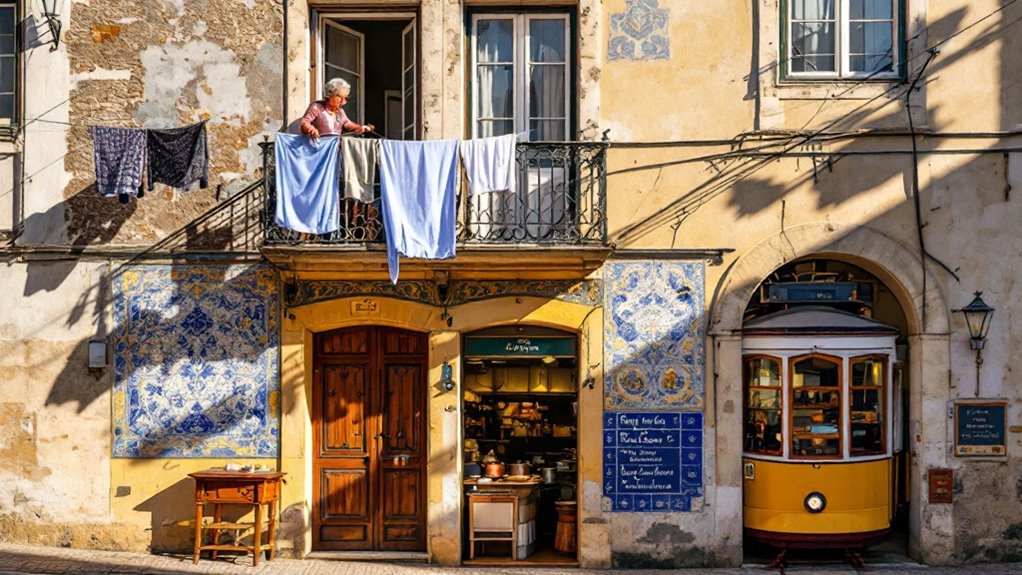
Lisbon’s cultural riches don’t require deep pockets to explore, making it one of Europe’s most accessible capitals for budget-conscious travelers.
You’ll find free entry to the magnificent Jerónimos Monastery on the first Sunday of each month, while the city’s network of miradouros offers breathtaking panoramic views without spending a cent. Waking up early to visit Miradouro das Portas do Sol rewards you with unforgettable sunrise views over the city. Like the charming cafes of Cuenca, Lisbon’s historic cafes provide atmospheric spots to experience local culture affordably.
The street art scene transforms entire neighborhoods into open-air galleries, where you can explore political murals and commissioned works using free maps from tourist offices. Using travel planning apps helps you discover hidden street art gems and local cultural events. Consider downloading GPSMyCity app for self-guided walking tours of Lisbon’s vibrant street art districts.
Deep within Portugal’s culinary soul, you’ll discover that seafood isn’t just food—it’s a living connection to centuries of maritime heritage.
For a delightful contrast, San Sebastian’s Green Spot cafe offers innovative vegan twists on traditional seafood dishes.
You’ll find this heritage alive at Cervejaria Ramiro, where Anthony Bourdain’s favorite garlic shrimp sizzles in traditional copper pans, or at Baía do Peixe, where platters overflow with fresh lobster and tiger prawns. The restaurant’s fairy-lit terrace creates an enchanting seaside ambiance steps from the historic Arco da Rua Augusta.
Much like Guadalajara’s Mercado Libertad, where locals gather for authentic flavors, Lisbon’s seafood markets pulse with daily activity and fresh catches. Like Australia’s coastal markets, these vibrant venues showcase the day’s bounty from local fishing boats.
Don’t miss the chance to savor bacalhau à brás, a dish that tells the story of Portugal’s seafaring explorers through salted cod, or experience the theatrical presentation of cataplana stew at Ponto Final, where you’ll dine riverside with views of Cristo Rei.
For an authentic taste of local tradition, time your visit with June’s Santo António festivals, when the aroma of grilled sardines fills Lisbon’s winding streets.
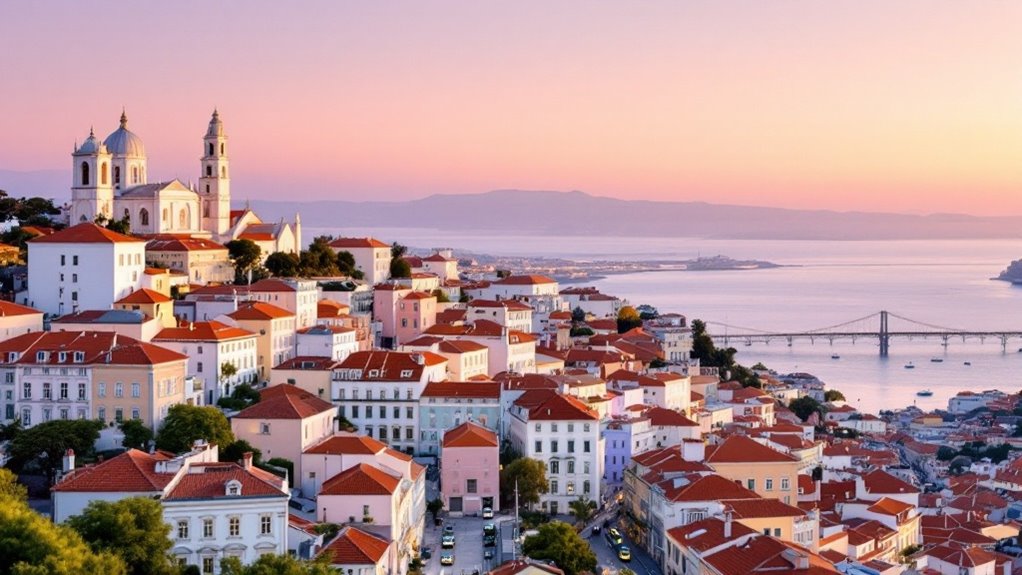
What better way to experience Lisbon’s soul than from its stunning rooftop sanctuaries?
Just like bike tour routes through Europe, Lisbon’s elevated viewpoints offer a unique way to explore the city’s landscape. The cooling breeze reminds me of the highland climate in Malaysia’s mountainous regions. Much like the Mayan ruins of Tulum, these viewpoints tell stories of the city’s rich history.
You’ll find yourself drawn to iconic spots like Sky Bar Oriente, where the Tagus River stretches beneath you from the 16th floor, or the vibrant Mundial Rooftop Bar, where sunset parties bring the city’s heart to life. Lost In offers a unique Mediterranean-Asian fusion dining experience with stunning city views through its glass walls.
Hidden gems like Memmo Alfama offer intimate views of the historic district, while Lumi Rooftop provides spectacular vistas of downtown landmarks.
Whether you’re seeking modern cityscapes or historic rooftops, Lisbon’s elevated venues perfectly capture the city’s timeless charm.
While Lisbon’s rooftops offer magnificent views of the city, the real magic unfolds at street level, where centuries of history blend seamlessly with contemporary life.
You’ll find UNESCO-protected Fado music echoing through Alfama’s Moorish alleys, while street artists create bold murals in nearby metro stations. Much like Argentina’s British tea culture, Lisbon embraces foreign influences while maintaining its distinct identity. Just as natural landscapes define New York’s Central Park, Lisbon’s hills shape its unique urban character.
The historic Baixa district showcases 18th-century engineering marvels, including earthquake-resistant buildings that still stand proud today. The area’s urban design reflects the revolutionary Pombalino Plan, which introduced standardized architecture after the devastating 1755 earthquake.
For a perfect blend of old and new, head to LX Factory, where a former industrial complex now buzzes with creative workspaces and trendy cafes. The vibrant atmosphere here rivals the energy found in Southeast Asian markets, where tradition and modernity also collide.
Don’t miss the Parque das Nações, where the futuristic Oceanarium sits alongside traditional Portuguese tilework, proving that Lisbon’s not just preserving its past – it’s actively reimagining it.

Traveling to Lisbon becomes even more magical when you’re sharing the experience across generations. The city’s family-friendly infrastructure makes it easy to plan activities that’ll delight everyone, from grandparents to young children.
Lisbon’s charm multiplies when experienced together, offering endless ways for families to explore, bond and create lasting memories across generations.
You’ll find thoughtfully designed spaces where different age groups can connect, learn, and create memories together. The city’s community hubs offer fun gatherings where families can enjoy music, games, and art activities together. Compared to living costs in Berlin, Lisbon offers excellent value for accommodating large family groups. Many English teaching professionals choose Lisbon as their European base while pursuing international education opportunities. Like Beijing’s Temple of Heaven, Lisbon’s historic sites provide peaceful spaces where families can explore cultural heritage at their own pace.
These multi-generational experiences help you embrace Lisbon’s culture while strengthening family bonds.
Beyond the well-worn paths of São Jorge Castle and Belém Tower lies a Lisbon that most travelers never discover.
You’ll find hidden gems like Cantina das Freiras, a convent-affiliated cafeteria offering €7 lunches with spectacular terrace views, and secret Chinese restaurants tucked away in residential buildings where daily menus are left to the chef’s discretion.
In Mouraria’s winding alleys, you can explore Cape Verdean eateries and Indian spice shops, while the Alvalade district showcases authentic Art Nouveau architecture and local café culture. Taking a guided food tour with a local expert reveals the best spots for fresh seafood and traditional pastries that travelers rarely find.
Many restaurants embrace Ayurvedic principles in their vegetarian offerings, balancing flavors and nutritional elements according to ancient wisdom. The city’s thriving vegan scene draws inspiration from Berlin’s renowned plant-based brunches.
For an immersive dining experience, platforms like Eatwith connect you with Lisbon residents who’ll welcome you into their homes for traditional meals, and family-run tascas serve grilled seafood and meats for under €10.
Much like Mexico City’s Condesa district, Lisbon’s neighborhoods each have their own distinct personality and culinary traditions worth exploring.
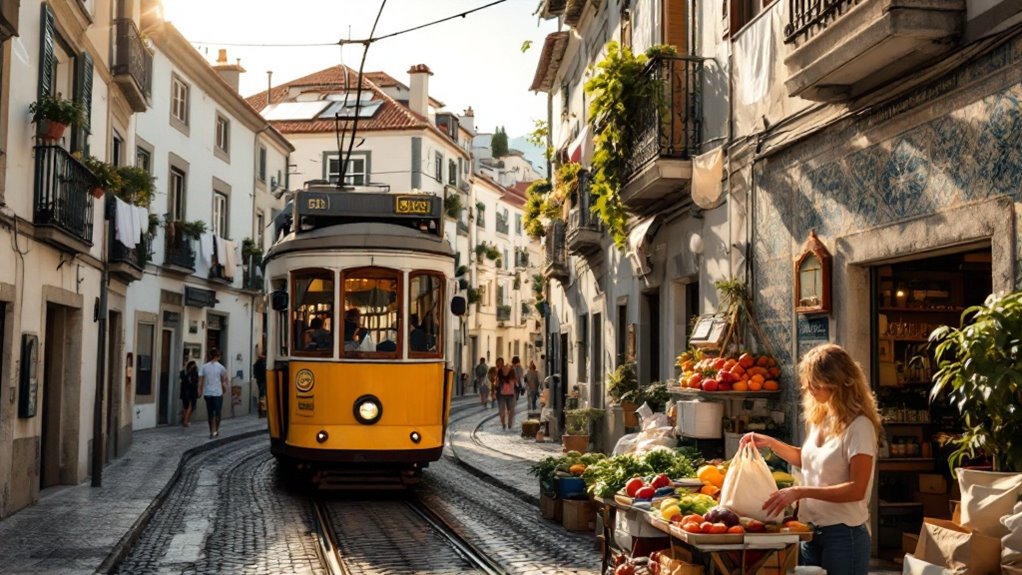
Lisbon’s commitment to sustainable tourism extends far beyond its charming local neighborhoods and hidden gems.
The city’s dedication shows in its innovative eco-conscious accommodations, where hotels like Immerso Ericeira use solar panels and support beach clean-ups, while historic buildings are thoughtfully repurposed with modern eco-design. The Lisbon Sustainable Tourism 2027 initiative demonstrates the city’s long-term vision for balancing visitor experiences with resident needs.
You’ll notice the city’s green initiatives everywhere you go, from the extensive public transport network to the pedestrian-friendly streets that make exploring on foot a joy.
While staying in Portugal’s capital, you’ll discover that its strategic location makes it an unbeatable hub for exploring the country’s most enchanting destinations.
You can hop on a 40-minute train to explore Sintra’s fairy-tale palaces, drive just 30 minutes to surf at Guincho Beach, or take a quick ferry to spot dolphins in Setúbal’s crystal waters.
From enchanting palaces to surfing spots and dolphin-watching adventures, Lisbon’s surrounding treasures are just a short journey away.
Spanning an impressive 17.2 kilometers long, the Vasco da Gama Bridge serves as a gateway to countless adventures beyond the city.
The city’s efficient transport network puts adventure at your fingertips: high-speed trains from Oriente Station connect you to Porto and Faro, while the nearby Vasco da Gama Bridge opens up the stunning Alentejo region.
Whether you’re kayaking past historic landmarks on the Tagus River, hiking the dramatic cliffs of Arrábida Natural Park, or cycling along Belém’s riverside path, Lisbon serves as your perfect launch pad for countless Portuguese adventures.
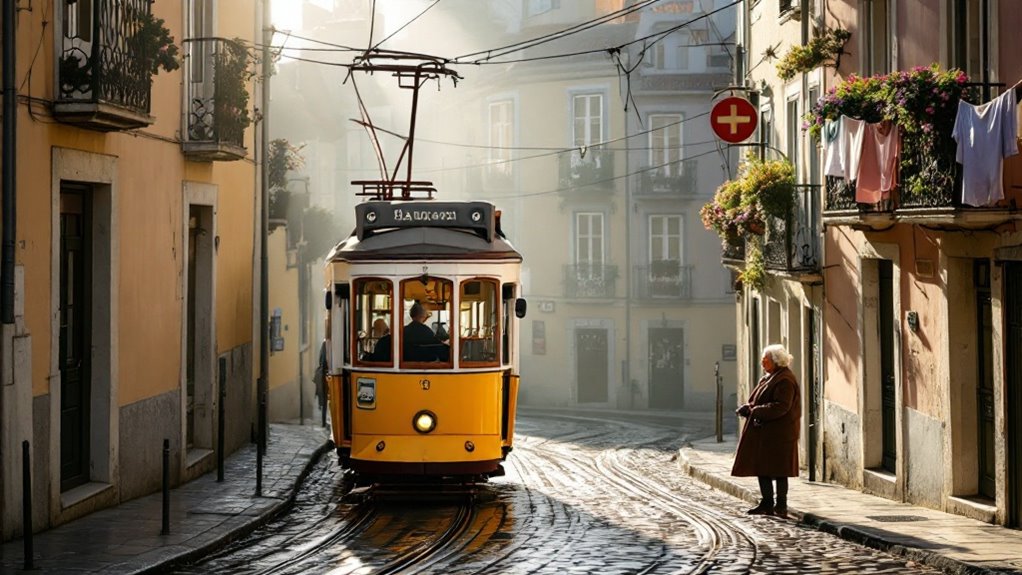
Most travelers assume summer is the only time to experience Portugal’s capital, but savvy visitors know that Lisbon’s magic shines brightest during the off-season months.
You’ll find mild winter temperatures perfect for exploring, with daytime highs reaching 15°C and plenty of sunshine to illuminate those iconic viewpoints. Without the summer crowds, you can truly appreciate the city’s UNESCO sites and cultural treasures at your own pace. The enchanting Alfama district’s cobblestone streets become even more atmospheric during winter months.
Despite rapid modernization sweeping through European capitals, Lisbon stands apart as a city that’s mastered the delicate balance between preserving its cultural legacy and embracing innovation.
Lisbon uniquely balances its rich heritage with modern progress, creating a rare harmony between past and present.
You’ll discover this harmony in the Museum of Lisbon, where ancient artifacts sit alongside urban planning exhibits, and in the June Festivals, where traditional St. Anthony processions blend with electronic music performances.
You can explore this cultural fusion in neighborhoods like Alfama, where Moorish alleyways house both traditional Fado venues and contemporary art galleries.
The city’s culinary scene reflects this duality too, with century-old fish shops adopting modern verification technology and classic bacalhau dishes reimagined through molecular gastronomy.
Thanks to thoughtful policies like the Creative Industries Strategy and controlled rent increases, you’ll experience a city that’s authentically Portuguese while confidently stepping into the future. This commitment to cultural preservation is evident in innovative museum programs like Stories in the City, which helps young immigrants connect with local heritage while maintaining their own identity.
Light as a feather on your wallet, Lisbon’s winter months (December-February) offer the best value. You’ll find hotel rates around $100/night, fewer travelers, and comfortable daytime temperatures hovering around 60°F.
You won’t find direct trains from Lisbon to major European cities anymore. The historic Sud Express and Lusitania night trains were discontinued in 2020. You’ll need to make connections through Spain for European rail travel.
You’ll find Lisbon moderately accessible, with 90% lowered curbs and adapted public transport. While historic areas pose challenges with cobblestones and hills, modern facilities, accessible tours, and specialized taxi services help overcome obstacles.
You’ll find a mountain of rental options in Lisbon. You can expect to pay €1,200-€1,415 for one-bedrooms downtown, €700-€900 for studios, or save money with €400-€550 shared rooms in the city.
You’ll find most mid to high-end establishments accept Visa and Mastercard, but carry some cash. Small family restaurants and local shops often prefer cash, while tourist areas widely accept international cards.
Whether you’re savoring pastéis de nata in a centuries-old café or admiring street art in a modern gallery, you’ll find Lisbon’s magic in its contrasts. The city seamlessly blends historic charm with forward-thinking sustainability, late-night energy with leisurely afternoons, and local traditions with global influences. You’ll discover why travelers can’t resist returning to this affordable, authentic gem where every visit reveals new layers of Portuguese culture.